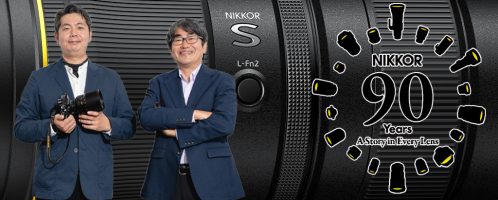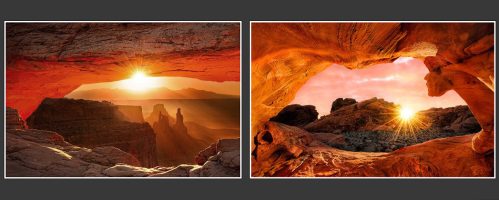At one time or another, we all face the dilemma – RAW or Jpeg? Have you ever found yourself wondering if you’re shooting the best format for your work? Do you really know the advantages and disadvantages of each format?
In the video below, I’ll explain everything you need to know. 🙂
We’ll look at why so many people can’t see a difference between the two formats (and why they’re looking at the wrong thing). We’ll look at the REAL reasons why you can do more with RAW files. Of course, we’ll check out side-by-side RAW and Jpeg example images too – underexposed, overexposed, and even properly exposed. (If you’ve only shot Jpeg thus far, these may blow your mind!)
In short, I’ll show you why RAW is the better choice for many photographers. And when Jpegs are just fine as well.
As an added bonus, after the main part of the video is over, I tacked on some information about 12 vs. 14 bit RAW and how to set up your Nikon or Sony camera for RAW shooting.
Enjoy! (and please share if you like it 🙂 )
.
PS – If you enjoyed this post, I think you’ll REALLY like my e-books and video workshops! Thousands of pages and hours of videos filled with tips, tricks, and techniques – all my best content! Check ’em out – click here (hey, it’s free to look).




Your video on raw vs jpeg is the most concise, well thought out, easy to understand, informative instruction on this issue. I finally get it. Thank You!
Would you useTIFF
You could, but there’s really no benefit to it over RAW. Tiffs are often larger than losses compressed RAW with no quality upside.
Hi Steve this video was very helpful and great, I’ve been shooting Jpeg but after watching this video I realized that I should immediately switch to RAW so I did but after taking some pictures in RAW for some reason I couldn’t open them up on my windows 10 or in lightroom.Do you have any idea what is wrong and how I can open/edit them?
Thanks, Rafael
The RAW profiles are likely out of date – usually an update is all that is required (should be the case for Win 10 – although you may need to google that one, I haven’t used Windows in a long time). For Lightroom it’s tricker. If you are using the current version, just update and you’ll see the files. If you’re using an older version, it’s still worth checking for an update, but that version may not support the RAW files from your camera – Adobe drops support for things like that. If that is the case, they do have… Read more »
Thanks a lot Steve
You may need to install the Windows 10 Nikon NEF Codec which will enable Win 10 to view your RAW files directly from the file system.
https://downloadcenter.nikonimglib.com/en/download/sw/97.html
Thanks Gerry
A real evergreen topic 🙂 and a splendid and comprehensive article about it. Thanks Steve ! I was lucky enough to have another pro like you explaing the thing to me and thus convincing me to go for RAW in 2014 just after changing over from my Fuji S5pro to Nikon – and I can perfectly understand the comment of Paul P. below 🙂 , The next step was switching to 12 bit RAW LC as a default. Being an amateur that has to be concious about budget in general and investment daisy chains following the purchase of a newer… Read more »
Great article Steve, thank you. I have been shooting RAW on my full frame Nikons for several years, (I used to shoot film as well) until I decided to add the D500 to my collection. Shooting mainly birds in RAW on the D500, the images looked like crap compared to my full frame Nikon bird images. I was really disappointed. I thought there was something wrong with the camera and tried changing the in-camera sharpening and also post processing the files, but nothing helped. I was ready to send the D500 back. Then one day I decided to try shooting… Read more »
Great stuff Steve !!!!!
Hey Steve, why the hell didn’t you make this RAW/JPEG video back in 2006, the year I switched from film to digital, and shot my daughter’s wedding with my brand new D200 in the beautiful city of Prague 😉 ? Not fully understanding the diff, I shot it all in JPEG. Turned out to be pretty good but boy, how I wish it were in RAW.
Anyways, another great video from my favourite photographer!
LOL, I don’t think I even knew the difference back then!! I was a film holdout 🙂
Yet another clearly demonstrated topic, well done Steve. Excellent. I find RAW invaluable for e.g. goosanders against dark river background where recovery from highlights can be crucial, and many other situations of course… sky details for example.
But do you have/use custom presets (or some other workflow) in Lightroom for less critical shots for easy bulk processing, which mimic the JPEG “better” than RAW effects in your first samples? To get the best of both worlds?!
I don’t have much int eh way of custom presets for it – other than one for my Z7 that adjusts the default noise reduction (I don’t like the way the adobe profile does it). Most of the time, I have no need to export a large portion of photos from a shoot – for example I just don’t need ten photos of a deer each with a slightly different pose – I need just the best one. However, if I did need to do something like that, I may just use the Camera Standard profile – most of the… Read more »
Thanks again Steve, very interesting I found an article by Nasim Mansurov in Photography Life which in addition to your reply should get me there.. keep up the good work
great discussion
Question: I’m trying to access the NEF (RAW) recording menu on the D850. It’s grayed out. How do I un-gray it?
That’s odd.
Check the Photo Shooting Menu > Image Size. Make sure it’s set to Large. See if that helps.
It sure did help. Thanks, Steve. And now it’s time to go outside and do a photo shoot. Nesting dove in the back yard!
Excellent video Steve! I was already convinced of using RAW instead of JPEG, since I read your ebook Secrets to Exposure and Metering for Nikon , section RAW VS JPEG; this video is an excellent link and introduction for your next Lightroom Development Module Video we hope to see very soon.
Have a nice day!
Christian
Steve, as always…great information! I have always understood RAW compared to JPeg and, with much less finesse than you, tried to explain to others. Your “LEGO” demonstration is one of the best explanations I’ve seen yet. You certainly have a gift at interpretation, instruction, and keeping the subject matter interesting. Please know that while it’s not always stated, you are definitely appreciated!
As always great video and informative content.
Very informative as usual. Why someone would shut JPG? I only imagine a person who has to send the files directly from the location. It makes sense before 5G will be available. Steve, can you make a video about those special people shutting 20 frames per second. Are they scientists?
LOL, I’m one of those “special people” 😀 I don’t use it all the time, but, for me I like it when I have rapidly moving wings – gives you more opportunities for the “perfect” moment. I’d also use it for any really fast action. However, most of the time I keep it at 12FPS.
Another really useful video. Thanks Steve and also for the section on fine tuning my Nikon settings.
in isolation in South Africa – stay safe in the US everybody.
Awesome and very informative video.. Thanks for all your effort.
Very good description of the 2 formats. I made the switch to RAW after a lot of jpg shooting. I wanted to edit more and have that RAW data available to work with. Tks Steve
Wonderful! You always manage to make it easy to understand
If you are concerned about running out of room on your memory card why don’t you carry an extra one? You can carry an extra battery too in case you use it up.
Just an example – it’s been years since I had any issues, I buy big cards 🙂 Still, I have seen others with the problem on workshops and 12 bit helps.
I used Nikon for years, but switched to Fuji in 2015. Your Jpeg vs Raw video was a very nice review of this subject.
Thanks
What does one lose with TIFF versus RAW for example when a photo is round tripped out to another program as RAW but comes back as TIFF early in the post processing process. Another of asking this is what does one lose in terms of editing flexibility by converting to TIFF in another program before completing Lightroom editing vs doing as much first as possible in Lightroom? From what I can tell one loses the ability to adjust white balance in the same degree and of course Lightroom Profiles. Does one also lose some of the ability to adjust exposure,… Read more »
I honestly haven’t tested it. The thing is, Tiffs are as large or larger than compressed NEFs and have already received some processing. So, I’m not sure there’s any real advantages.
Did not mean an advantage to TIFF. Rather how much of a disadvantage in using a TIFF rather than the Raw image because of the use of an add on program that round trips back to Lightroom as a TIFF For example, programs like Photoshop or one of the many plug ins. The more of a disadvantage in terms of flexibility in editing TIFFs have I would presume the later in the workflow one would want to use a plug in that generates TIFF. Yet certain plug ins such as Topaz Denoise suggest they should be used right in the… Read more »
Sorry, I get it now. Ideally, I’d want to get the color and exposure work done on the Tiff first, then send it over. Once it’s back, you can adjust things like clarity, sharpness, contrast, etc. (that’s how I do it anyway)
Thanks. That is what I would have thought. I saw you mentioned using Topaz DeNoise AI. I have just started playing with it. They recommend using that first which would mean a TIFF first. Do you do the adjustments you mention in Lightroom before going into Topaz DeNoise or go into it first as they suggest? I would have thought another advantage of doing Lightroom adjustments to exposure first would also have been to see the noise better.
I don’t agree with Topaz here. I think you should do exposure and WB for sure first (and maybe even a bit of vibrance or saturation if the image needs it). Basically, get the color and brightness levels correct first. Those are the things you really need the RAW data for.
Contrast, clarity, texture, dehaze, etc are usually fine to do with the edited Tiff – and I would want to do those after noise reduction anyway. However, I think you stand a chance of not having the best info by doing Topaz before exposure and WB.
Makes sense. Thanks and thanks for all your great videos and ebooks. Hope you are able to hang in there. I know photographers who do travel and workshops like you (hope to do one of yours one day) are among those hit particularly hard. Take care.
Like every time steve’s videos give us wonderfull and clear explainations,i can only say great!!
Thanks 🙂
The technical argument supports RAW. However, contrary to your comments, JPGS can be processed, frequently significantly. A properly exposed JPG needs very little processing. If you love post processing shoot RAW. Most people would never appreciate the difference.
It really depends on the shot. In the past I’ve been able to process jpegs – as you say, significantly – and they looked good. However, I’ve also run into problems like you saw in the video. As I mentioned in the video, Jpegs do have their advantages and everyone has different needs. I’m just pointing out that RAW has more more post-processing flexibility than Jpegs (and this is always the case, since the Jpegs are created from the RAW file). How much of that you need will vary by shot. In my mind, I’m better off shooting all of… Read more »
Yes of course some people will not appreciate the difference. But if you want to make great fotos , and want to do your best, you personnaly will know the differences ! people are not often educated, and they will not often see the differences between a great musician and a good amateur. Is this a reason not to try to be an artist because people cant see the difference ?
The point is there is often no visible difference between a properly exposed JPG with little or no processing and a RAW file where one has spent hours in “getting the image right”. In my opinion RAW is best suited for situations where extremely fine detail and minute gradations of color actually make a significant difference in image quality. I have done a series of test with various individuals and they could not spot a difference between a JPG and processed RAW image. If you are a photographer who is the only person viewing your images and you love post… Read more »
As usual a comprehensive presentation of the much debated topic made understandable.
Thanks! It took almost a week to do this one so I appreciate the comment 🙂
Another excellent presentation. Outstanding explanations on what to expect with raw and jpeg photos. Keep up the good work Steve
Thanks!
Excellent presentation and great that you mentioned the lack of gain with 14-bit RAW at ISO above 400. Key for me is that the tonality is compressed with 8-bit capture and I see it quite noticeably with the yellows in a subject or scene. JPEG is mentioned as lossy and that results in image degradation each time a file is opened and then saved. Try doing a PS action to open and save a JPEG file 20 times and compare the first and the last image.
LOL – I have done that PS experiment 😀
Great easily understandable RAW vs Jpeg diagnosis and information. I am sure this make for people aware of the advantages of RAW and the subsequent Post Processing.
Thanks!
Steve, for me and the way my head works (or doesn’t work), your explanation/demonstration is the best I’ve seen on the subject of raw vs jpeg. I have been teetering on the brink of going to raw for about a year now. Your video has got me convinced! I’m going to take the plunge. In the past, before your latest video, I just hadn’t seen what I would gain in such a graphic manner as your video demonstrates it. I have purchased some of your books and I recommend your site to photogs I meet in various places. Thanks!
Awesome – I think you’ll enjoy the switch. 🙂
Great video. It brought to mind a session at PhotoShop World years ago when the Nikon D100 was brand new. One of the professional photographers leading the session spoke about RAW format, saying that for the first time in history, we now have negatives (digital negatives in RAW format) that will actually get better with age. The reason for that is that the algorithms translating RAW data to a working format will continue to get better and better. We are lucky to live in an era where the chips get better, the translation gets better and our tools (LR/ACR +… Read more »
That’s a great point (DoH! – wish I would have mentioned it in the video). But it’s very true – our post processing tools get better and better and we can now do things we never imagined a decade ago (Just look at Topaz Denoise AI).
As I was reading the comments I was going to come on to basically say what you have. As someone who started out with film (yes, I’m an old guy), the first thing I had to get use to with digital was the idea to shoot way more pics than I did with film because I can delete later. Something Steve has mentioned elsewhere. The other was the ability to alter/process an image. From the beginning I saw the usefulness of shooting RAW for this reason and because I was just getting started in the digital world I could easily… Read more »
Thanks for the kind words and your comments Mike 🙂